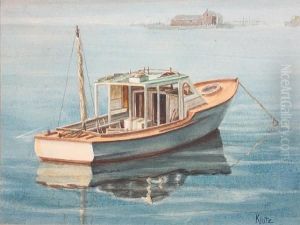Edmund Klotz Paintings
Edmund Klotz was a German artist, born in 1868. Despite not being as widely recognized as some of his contemporaries, Klotz made significant contributions to the art world of his time, particularly in the fields of painting and graphic design. His work, characterized by its detailed realism and often vibrant use of color, provides a glimpse into the artistic trends and societal concerns of late 19th and early 20th century Germany.
Klotz received his art education at the prestigious Academy of Fine Arts in Munich, a center for artistic training that produced many notable artists of the period. Here, he was influenced by the teachings of classical realism, a style that he would both embrace and evolve in his own artistic practice. Throughout his career, Klotz exhibited a keen interest in capturing the essence of his subjects, whether they were landscapes, urban scenes, or portraits, with a particular focus on the interplay of light and shadow.
In addition to his paintings, Klotz was also known for his graphic work, contributing illustrations to various publications of the time. This aspect of his career highlights the artist's versatility and his ability to adapt his skills to different mediums and formats. His illustrations often featured intricate details and a depth of expression that complemented the narrative of the texts they accompanied.
During his lifetime, Klotz's work was exhibited in various galleries across Germany, receiving acclaim for its technical proficiency and emotional depth. Despite this, his legacy has been somewhat overshadowed by other artists of his era, a fact that has led to a renewed interest in his work among art historians and collectors in recent years.
Edmund Klotz passed away in 1951, leaving behind a body of work that continues to be studied and appreciated for its contribution to the development of German art in the late 19th and early 20th centuries. His paintings and illustrations not only reflect the artistic movements of his time but also offer a window into the cultural and societal shifts occurring in Germany during his lifetime.
